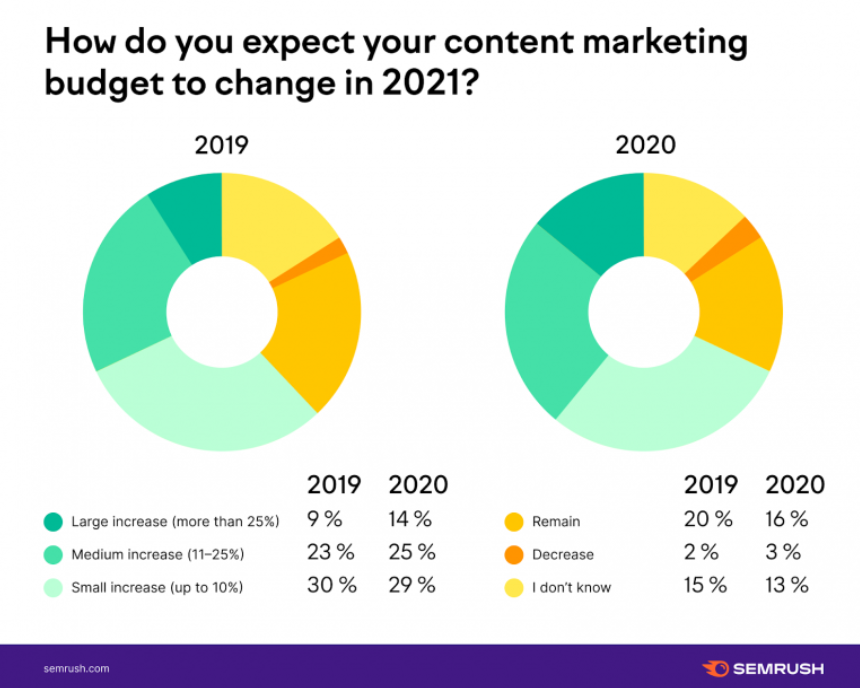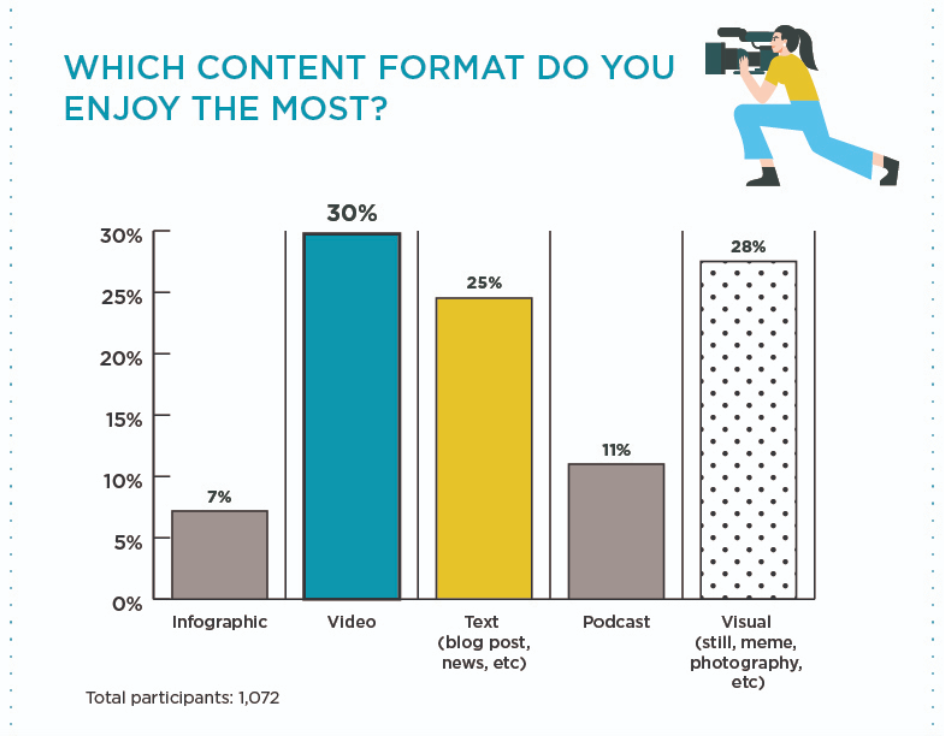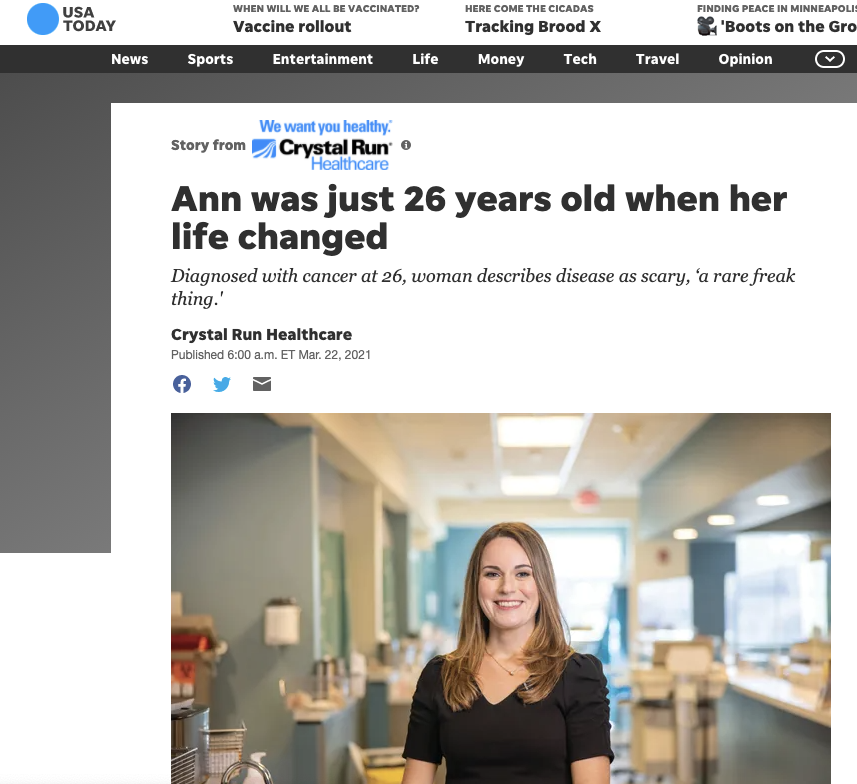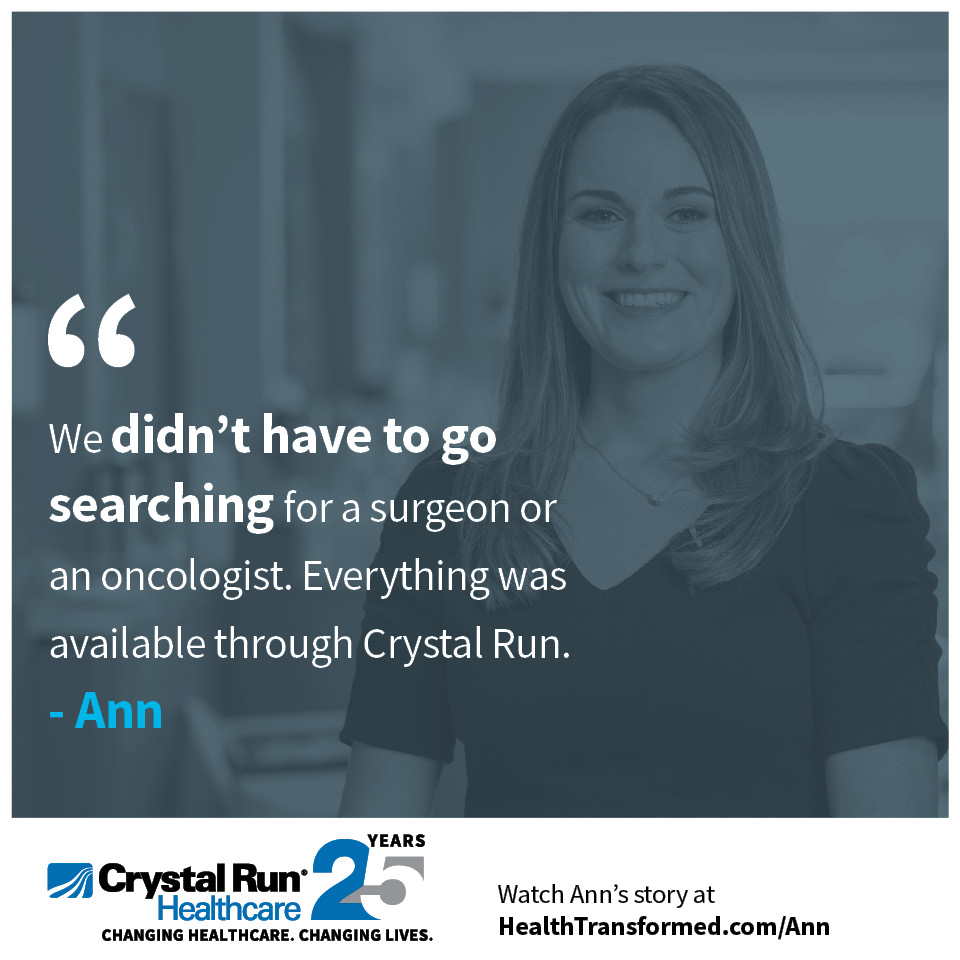COVID-19 has changed the way consumers and brands interact with each other, motivating many people to use digital channels in new and innovative ways. For marketers, the acceleration of digitally-focused interactions required a renewed focus on content creation and strategy throughout 2020.
The demand for content has continued into 2021, with 68% of B2B and B2C marketers surveyed by SEMRush indicating they plan to increase their content marketing budget in some capacity.
Source: SEMrush
Increased competition for consumer attention is a very real pain point for businesses right now. There’s a huge amount of content available across a variety of touchpoints and channels, all of it vying for consumer attention. In their 2021 Global Marketing Trends study of over 2400 consumers, Deloitte reported that people are exposed to between 400 and 10,000 advertisements per day.
Knowing how to repurpose, simplify, and shorten complex content so that it presents your story in a compelling way can help your brand stand out in a hyper-cluttered content landscape. There is a time and place for shorter content. In this post, we explore the current content landscape with the goal of helping you plan a more effective content approach for the coming year.
Content is about context
Certain channels beget shorter content, particularly social media. Instagram’s focus on images only, Twitter’s microblogging format that allows up to 240 characters along with images and video, and Snapchat’s limit of video length to 60 seconds are a few examples. Short narrative content that incorporates a combination of video, audio, text, effects, and interactive features (and lives outside of the standard social media feed)—e.g., Stories—is also popular among consumers, with 35% of people saying they prefer to engage with short narrative-style Instagram Stories.
While content on your web site and in your print materials can include long video tutorials, multi-page ebooks, whitepapers, and hour-long webinars, the content you create for social channels, ads, and mobile touchpoints should be (much) shorter. But that doesn’t mean it shouldn’t be compelling.
When we work with clients to broadcast a large or complex brand story, we plan a variety of content types, including short-form content that carefully considers how much information to give away in an ad or social media.
From a B2B perspective, content forms the foundation of the buying journey. B2B executives consume an average of 17 pieces of content over the course of the sales cycle, with 79% of buyers saying that the content provided by sales reps is extremely influential in their buying decision. Using shorter content can help busy buyers quickly understand if a product or solution is relevant to them.
It’s all about context. Marketers must create content in a variety of lengths and types that addresses multiple channels and touchpoints. But this begs the question—how, exactly, do consumers consume content.
How do consumers consume content?
When developing a content strategy that incorporates different content types, it’s helpful to know what consumers prefer. Unsurprisingly, visual content tends to win out over text, podcasts and even infographics.
In a survey of over 1000 consumers by Contently, 30% of respondents said they enjoy video the most and 28% preferred visual short form content (e.g., memes, stills, photography). This isn’t much higher than those who preferred text-based content (25%) but it’s considerably higher than podcasts and infographics, as the below chart demonstrates.
Source: Contently
Now, consider that:
- 58% of viewers watch a video to the end if it’s less than 60 seconds (but only 45% will watch a video all the way through, regardless of length).
- Tweets with video get 10x more engagement than those without.
- Articles with an image every 75-100 words receive double the social media shares as those with fewer images.
- The optimal video length (for user engagement) on Facebook is between 2 and 5 minutes.
- Instructional content does well on Pinterest, with 84% of Pinterest users saying that Pinterest helps them learn new things.
There are a couple of things that stand out about the above statistics. The first is that each platform is different (remember, we’re talking about context here). While more than half of viewers watch a 60 second video to the end, the optimal length of videos on Facebook is between 2 and 5 minutes. When planning out your content, it’s helpful what works best on each platform so you can create platform-specific content pieces.
The other thing that stands out is that pairing images or video with shorter text-based content (e.g., Tweets) tends to make it perform better. When planning content, you should be asking:
- Where exactly will your videos (or stories) appear?
- What is the ideal length of the video or story or post for the given social channel?
- Are you targeting a B2B or B2C audience?
- What are the demographics you’re targeting and how do they react with the channel you’re sharing/posting content to?
Asking questions like these will help you plan your content strategically from the beginning. This includes longform content like eBooks or catalogues which you can mine to tell shorter stories. How can you do that? We thought you’d never ask.
Examples of how we cut a long story short
We work with clients across multiple channels and industries, using a variety of content types including web pages, photography, print, video, mobile apps, text and image ads, and more. We often repurpose our clients’ existing longform content into shorter pieces for use as ad copy and on social media. Here are some more examples of how we cut a long story short.
- Ashworth Creative has written and designed long form catalogs for Harney & Sons Fine Teas written to spell out themes. Most recently our 74 page catalog was themed “Tea Time is Anytime,” an expression coined by their founder, John Harney. Another theme woven into the book was Tea for Two. Those 74 pages of content turn up in many forms and provide fodder for social media and more.
- For the City of Poughkeepsie Ashworth scripted and filmed a mini-documentary about how the water drawn from the Hudson River ends up as clean water for the citizens of Poughkeepsie to enjoy from their taps. As we toured the City’s water treatment plant, it took an hour to go through each process, a very long time for an audience to hang on through it all. We concluded that we could relay the water treatment process with a short animated sequence which held attention and made the point. We created the animations in-house and the video was 6 minutes long and not sixty six! Short segments were used in social media to invite people to view the video and the content was repurposed in a variety of ways.
- Recently, Ashworth Creative created a campaign for Crystal Run Healthcare that, as part of their 25th anniversary celebrations, told the story of a 26 year old woman diagnosed with stage three cancer. Her story was fully told in a 5-minute video with additional 60 second, 30 second and 15 second versions that acted as a trailer leading to the long form video which was housed on their website. In digital and social media, the audience was driven to the 5 minute version which prompted high visitation to the website and to a landing page where the opportunity to view the video was possible but the story was also told with written content and stills. The story had multiple layers: doctors from different specialities working together, the fact that the young woman was so inspired that she changed careers and became a nurse as a result of her experiences, and that she’s marrying her career firefighter fiancé and, most of all that she’s two years in remission. We gauged how much story to tell and chose the amount according to the medium in which it appeared.
From changing messaging to communicating safety protocols to announcing innovative new products and services, content of all lengths and mediums has remained instrumental for businesses and consumers alike. Shorter content like infographics, video clips, images, and even memes can help you communicate your brand story to consumers in creative, compelling, and authentic ways.
Short content can be used to direct people to a landing page or longer piece of content like a whitepaper, where they can learn more about your product, service, or brand. Creating content with the entire customer journey in mind enables you to more easily repurpose or simplify longform content, plus it provides a better user experience, ensuring your brand story is seamless across all customer channels and touchpoints.





